American Alligator (Alligator mississippiensis)
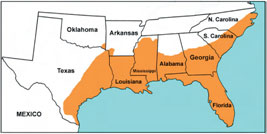 Alligator mississippiensis is one of the best-known crocodilians. It is widespread in a variety of wetland habitats in the southeastern United States of America, and under enlightened management programs, has made a remarkable comeback from the days of uncontrolled hunting. Carefully controlled harvest programs are now in place in Louisiana, Texas, South Carolina and Florida.
Alligator mississippiensis is one of the best-known crocodilians. It is widespread in a variety of wetland habitats in the southeastern United States of America, and under enlightened management programs, has made a remarkable comeback from the days of uncontrolled hunting. Carefully controlled harvest programs are now in place in Louisiana, Texas, South Carolina and Florida.
Alligators are usually associated with fresh or brackish water, with some individuals venturing into saline water for short periods. Their principal habitats are swamps and marshes, but they also occur in lakes, rivers and streams. In Louisiana, adult and subadult males prefer open water areas and females prefer more secluded, heavily vegetated sites.
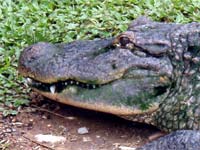 Female alligators lay an average of 40 eggs in a mound nest. Ambient air temperatures affect the timing of nesting and egg-laying. In Louisiana, low spring (March-May) temperatures cause nesting to occur as late as the first week of July, whereas with high ambient temperatures nesting occurs in early June.
Female alligators lay an average of 40 eggs in a mound nest. Ambient air temperatures affect the timing of nesting and egg-laying. In Louisiana, low spring (March-May) temperatures cause nesting to occur as late as the first week of July, whereas with high ambient temperatures nesting occurs in early June.
Females mature at about 1.8 m length, and the largest females are about 2.8 m long. Some males may exceed 4 m total length - they rarely exceed 4.5 m, although some historical accounts suggest that some individuals may get larger.
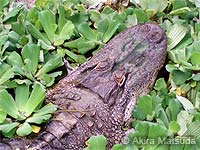 During cooler months of the year, alligators remain inactive, within dens. In some cases hatchlings will overwinter with the female in her den.
During cooler months of the year, alligators remain inactive, within dens. In some cases hatchlings will overwinter with the female in her den.
Overall, alligator numbers are increasing. In the State of Florida, over 5000 complaints about "nuisance" alligators are received each year. Alligators regularly eat dogs and cats, but are generally too small to be a common predator on humans. Nevertheless, there have been numerous unprovoked attacks by alligators on people, resulting in 17 fatalities since the late 1940s (see Crocodilian Attacks [interlink to corresponding section]).
Chinese Alligator (Alligator sinensis)
 The Chinese Alligator is the only alligatorid outside the Americas, and it is restricted to the lower Yangtze valley in Anhui, Zhejiang and Jiangsu Provinces in China. Like the Gharial on the Indian subcontinent, it has fared pretty badly due to human population pressures. Alligators are mentioned in Chinese literature from around 1300 BC, and it is possible that the dragons in Chinese art and mythology were based on this species.
The Chinese Alligator is the only alligatorid outside the Americas, and it is restricted to the lower Yangtze valley in Anhui, Zhejiang and Jiangsu Provinces in China. Like the Gharial on the Indian subcontinent, it has fared pretty badly due to human population pressures. Alligators are mentioned in Chinese literature from around 1300 BC, and it is possible that the dragons in Chinese art and mythology were based on this species.
Alligator sinensis is a small species, typically less than 2 m long, which spends most of its life in burrows. From late October to mid-April, they hibernate in burrows that they excavated in the sides of river banks. During the early and late stages of this period they may leave their burrows, although they are sluggish, but otherwise they do not feed or move during the period of aestivation. Body functions slow as temperatures drop - as low as 10oC.
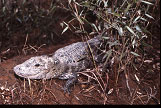 Sexual maturity is reached at about 4-5 years of age. Mating occurs in June, and in July-August 10-40 eggs are laid in a mound nest. Incubation takes about 70 days, and the hatchlings are typically black with yellow stripes, about 21 cm long and about 30 g in weight. Diet consists mainly of snails, mussels and fish, though adults may take larger vertebrate prey.
Sexual maturity is reached at about 4-5 years of age. Mating occurs in June, and in July-August 10-40 eggs are laid in a mound nest. Incubation takes about 70 days, and the hatchlings are typically black with yellow stripes, about 21 cm long and about 30 g in weight. Diet consists mainly of snails, mussels and fish, though adults may take larger vertebrate prey.
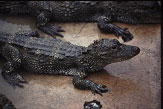 Conservation efforts in China allowed a captive breeding Centre in Anhui Province to be established, and there are now over 10,000 captive Chinese Alligators. The wild population is now estimated to be less than 150 individuals, with subpopulations small (no more 10 individuals) and fragmented. Chinese authorities have begun experimental restocking of wild habitats with captive-bred alligators, with the first releases being monitored by radio-telemetry to monitor survival and movement. Efforts are also being made to identify and secure new suitable sites for future restocking to augment the wild alligator population. The species is listed as “Critically Endangered” on the IUCN Red List of Threatened Species.
Conservation efforts in China allowed a captive breeding Centre in Anhui Province to be established, and there are now over 10,000 captive Chinese Alligators. The wild population is now estimated to be less than 150 individuals, with subpopulations small (no more 10 individuals) and fragmented. Chinese authorities have begun experimental restocking of wild habitats with captive-bred alligators, with the first releases being monitored by radio-telemetry to monitor survival and movement. Efforts are also being made to identify and secure new suitable sites for future restocking to augment the wild alligator population. The species is listed as “Critically Endangered” on the IUCN Red List of Threatened Species.
The species has also bred in captivity in the USA, at Rockefeller Refuge (Louisiana), Bronx Zoo (New York) and St. Augustine Alligator Farm Zoological Park (Florida).

 Email CSG
Email CSG Alligator mississippiensis is one of the best-known crocodilians. It is widespread in a variety of wetland habitats in the southeastern United States of America, and under enlightened management programs, has made a remarkable comeback from the days of uncontrolled hunting. Carefully controlled harvest programs are now in place in Louisiana, Texas, South Carolina and Florida.
Alligator mississippiensis is one of the best-known crocodilians. It is widespread in a variety of wetland habitats in the southeastern United States of America, and under enlightened management programs, has made a remarkable comeback from the days of uncontrolled hunting. Carefully controlled harvest programs are now in place in Louisiana, Texas, South Carolina and Florida. Female alligators lay an average of 40 eggs in a mound nest. Ambient air temperatures affect the timing of nesting and egg-laying. In Louisiana, low spring (March-May) temperatures cause nesting to occur as late as the first week of July, whereas with high ambient temperatures nesting occurs in early June.
Female alligators lay an average of 40 eggs in a mound nest. Ambient air temperatures affect the timing of nesting and egg-laying. In Louisiana, low spring (March-May) temperatures cause nesting to occur as late as the first week of July, whereas with high ambient temperatures nesting occurs in early June. During cooler months of the year, alligators remain inactive, within dens. In some cases hatchlings will overwinter with the female in her den.
During cooler months of the year, alligators remain inactive, within dens. In some cases hatchlings will overwinter with the female in her den.  The Chinese Alligator is the only alligatorid outside the Americas, and it is restricted to the lower Yangtze valley in Anhui, Zhejiang and Jiangsu Provinces in China. Like the Gharial on the Indian subcontinent, it has fared pretty badly due to human population pressures. Alligators are mentioned in Chinese literature from around 1300 BC, and it is possible that the dragons in Chinese art and mythology were based on this species.
The Chinese Alligator is the only alligatorid outside the Americas, and it is restricted to the lower Yangtze valley in Anhui, Zhejiang and Jiangsu Provinces in China. Like the Gharial on the Indian subcontinent, it has fared pretty badly due to human population pressures. Alligators are mentioned in Chinese literature from around 1300 BC, and it is possible that the dragons in Chinese art and mythology were based on this species. Sexual maturity is reached at about 4-5 years of age. Mating occurs in June, and in July-August 10-40 eggs are laid in a mound nest. Incubation takes about 70 days, and the hatchlings are typically black with yellow stripes, about 21 cm long and about 30 g in weight. Diet consists mainly of snails, mussels and fish, though adults may take larger vertebrate prey.
Sexual maturity is reached at about 4-5 years of age. Mating occurs in June, and in July-August 10-40 eggs are laid in a mound nest. Incubation takes about 70 days, and the hatchlings are typically black with yellow stripes, about 21 cm long and about 30 g in weight. Diet consists mainly of snails, mussels and fish, though adults may take larger vertebrate prey. Conservation efforts in China allowed a captive breeding Centre in Anhui Province to be established, and there are now over 10,000 captive Chinese Alligators. The wild population is now estimated to be less than 150 individuals, with subpopulations small (no more 10 individuals) and fragmented. Chinese authorities have begun experimental restocking of wild habitats with captive-bred alligators, with the first releases being monitored by radio-telemetry to monitor survival and movement. Efforts are also being made to identify and secure new suitable sites for future restocking to augment the wild alligator population. The species is listed as “Critically Endangered” on the
Conservation efforts in China allowed a captive breeding Centre in Anhui Province to be established, and there are now over 10,000 captive Chinese Alligators. The wild population is now estimated to be less than 150 individuals, with subpopulations small (no more 10 individuals) and fragmented. Chinese authorities have begun experimental restocking of wild habitats with captive-bred alligators, with the first releases being monitored by radio-telemetry to monitor survival and movement. Efforts are also being made to identify and secure new suitable sites for future restocking to augment the wild alligator population. The species is listed as “Critically Endangered” on the 